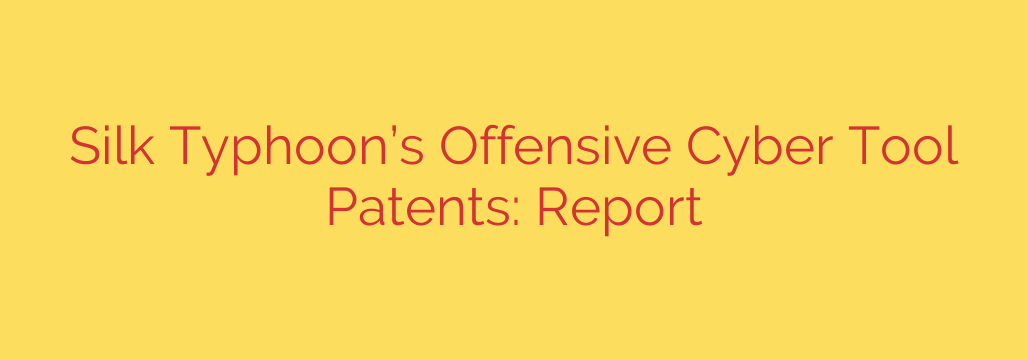
Patented Malware: How a Notorious Hacking Group is Formalizing Cyber Weapons
The world of cybersecurity is facing a chilling new reality: sophisticated threat actors are no longer just developing malicious tools in the shadows—they are patenting them. Recent findings have uncovered that a prominent Chinese hacking group, known as Silk Typhoon, has been linked to patents for offensive cyber tools, signaling a disturbing trend toward the formalization and commercialization of cyber warfare technology.
This development fundamentally alters our understanding of the cyber threat landscape. When a group known for espionage and cybercrime begins to file for intellectual property rights on its attack methods, it blurs the line between clandestine operations and legitimate corporate enterprise. It suggests a future where cyber weapons are not only deployed but are also developed, productized, and protected like any other commercial software.
Who is Silk Typhoon?
Silk Typhoon, also identified by cybersecurity researchers as Bronze Starlight and having connections to the infamous APT41, is a highly skilled and persistent threat actor. This group has a long history of targeting a wide range of industries, including technology, telecommunications, healthcare, and government agencies across the globe. Their primary motivations appear to be a mix of state-sponsored espionage and financially driven cybercrime, making them a versatile and dangerous adversary.
The direct link between this group and a Chinese technology company that filed the patents provides concrete evidence of a structured, corporate-like approach to creating and distributing hacking tools.
A Look Inside the Patented Attack Tools
The patents do not read like typical software documentation; they are technical blueprints for malicious activity. They detail systems designed to infiltrate networks, steal data, and remain undetected. Key capabilities described in the patents include:
- Advanced Data Exfiltration: One patent outlines a system for covertly sending stolen data back to the attackers. The tool is designed to disguise the malicious traffic as legitimate network activity, making it extremely difficult for standard security tools to detect the data breach as it happens.
- Stealth and Evasion: The group has patented methods for bypassing security software. This includes technology that can identify and evade antivirus programs and other defensive measures, allowing the malware to operate freely on a compromised system.
- Comprehensive Surveillance: The patents describe a spyware management platform that acts as a central command-and-control system. This platform can monitor network communications, gather system information, and manage other deployed spyware across multiple infected devices simultaneously.
- Network Traffic Interception: Another patented tool focuses on intercepting and analyzing network traffic to identify valuable information and credentials. This allows attackers to map out a network’s infrastructure and pinpoint high-value targets for further exploitation.
Why Patenting Hacking Tools is a Game-Changer
The act of patenting these tools is significant for several reasons. First, it represents a bold move toward legitimizing and commercializing cyber weapons. The group is treating its malicious code as valuable intellectual property, worthy of legal protection.
Second, it further blurs the already murky distinction between state-sponsored actors and private contractors. The corporate structure implied by filing patents suggests a professional operation that may be selling these tools to other entities or providing “hacking-as-a-service.”
Finally, while intended to protect their creations, these public patent filings offer a blueprint of the group’s tactics, techniques, and procedures (TTPs). Security researchers and defenders can analyze these documents to better understand the threat and develop countermeasures.
How to Defend Against Professionalized Threats
As threat actors evolve, so too must our defensive strategies. The emergence of patented, commercial-grade malware means that off-the-shelf security solutions are no longer sufficient. Organizations must adopt a more proactive and sophisticated security posture.
Here are actionable steps to enhance your defenses:
- Strengthen Threat Intelligence: Actively consume threat intelligence that provides insight into the latest TTPs used by groups like Silk Typhoon. Knowing what to look for is the first step in effective defense.
- Adopt a Zero-Trust Architecture: Operate under the assumption that a breach is inevitable or has already occurred. A zero-trust model requires strict verification for every user and device trying to access resources on your network, minimizing the potential for lateral movement by an attacker.
- Deploy Advanced Endpoint Detection and Response (EDR): Signature-based antivirus is not enough. EDR solutions monitor endpoint and network events, allowing you to detect, investigate, and respond to suspicious activities that indicate a sophisticated attack.
- Enhance Network Traffic Analysis: Since these new tools are designed to hide within normal traffic, deploying advanced network detection and response (NDR) solutions is critical. These tools use AI and machine learning to identify anomalous patterns that could signal a covert attack.
- Conduct Regular Penetration Testing: Proactively test your defenses against the very techniques detailed in these patents. Hire ethical hackers to simulate an attack from a sophisticated adversary to identify and remediate vulnerabilities before they are exploited.
The era of disorganized hacking is fading. In its place rises a professionalized industry of cyber weaponry, complete with R&D, corporate structures, and now, intellectual property. Staying ahead requires vigilance, investment in modern security frameworks, and an understanding that the threat is more organized and formidable than ever before.
Source: https://go.theregister.com/feed/www.theregister.com/2025/07/31/silk_typhoon_attack_patents/








